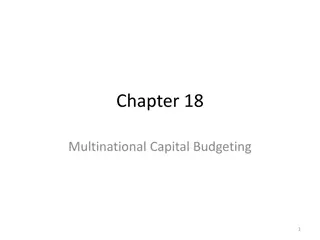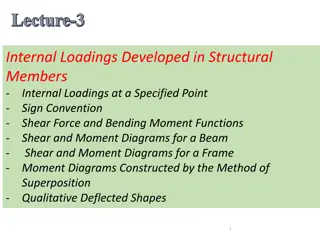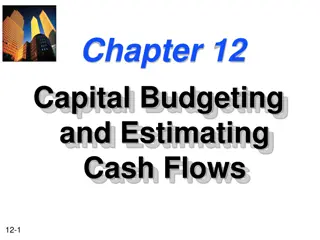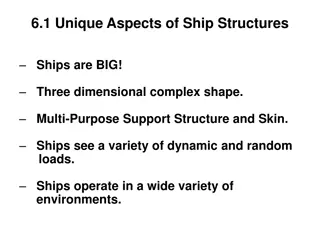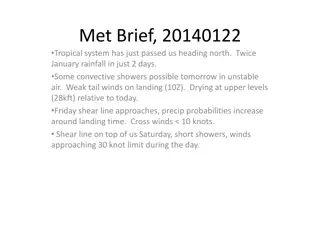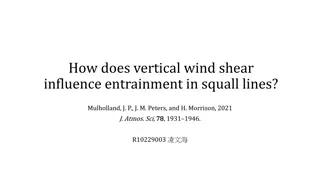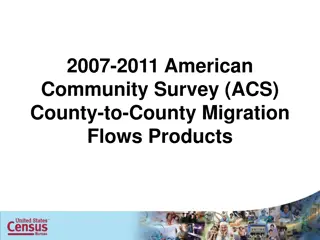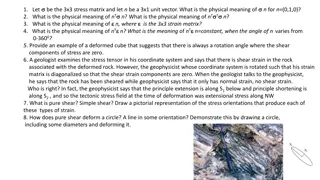Supply Chain Management - Importance, Drivers and Flows
Learn about the importance, drivers, and flows of supply chain management. Discover how it boosts customer service, reduces operating costs, improves financial position, and enhances quality of life.
8 views • 6 slides
Challenges in Multinational Capital Budgeting
Multinational Capital Budgeting extends the domestic analysis to evaluate foreign projects, focusing on cash flows, risk adjustments, and real option analysis. It involves complexities such as distinguishing parent cash flows from project cash flows, dealing with differing tax systems, political con
3 views • 15 slides
Effective Capital Budgeting Strategies for Long-Term Value Creation
Understanding the capital budgeting process is crucial for selecting investment projects that align with long-term value creation goals. This involves calculating cash flows, discount rates, and valuation methods to evaluate projects based on financial, social, and environmental dimensions. Estimati
0 views • 31 slides
Cryostat Engineering for SC Devices Training at CERN - November 2022
Explore the technical training on Cryostat Engineering for Superconducting devices at CERN in November 2022. Dive into the design aspects, static heat loads, and mass flows for a 400 MHz cryomodule. Tasks include conceptual design of cryostats, calculating thermal parameters, supporting systems, and
0 views • 10 slides
Understanding Internal Loadings in Structural Members
Internal loadings in structural members, such as beams and frames, are essential for design. This chapter explores the analysis of shear forces, bending moments, and axial forces, providing methods to determine these forces graphically using shear and moment diagrams. Learn about the sign convention
0 views • 35 slides
Real-Time Payments: Actors and Message Flows Overview
This document provides an overview of the actors involved in a payment flow and the message portfolio in Real-Time Payments (RTP). It includes details on various actors like Instructing agent, Forwarding agent, Ultimate Debtor, Reimbursement agents, and more. The provided message flows illustrate th
1 views • 12 slides
Understanding Capital Budgeting Process and Estimating Cash Flows
The capital budgeting process involves identifying and selecting investment projects with returns extending beyond a year. It includes generating proposals, estimating after-tax incremental cash flows, and selecting projects based on value-maximizing criteria. Investment project proposals are classi
0 views • 31 slides
Data Flows and Network Challenges in Particle Physics Infrastructure
This overview delves into the data flows and network challenges faced in particle physics infrastructure, focusing on the JUNO project. It discusses the process of data reception, storage, and replication across various data centers, highlighting the bidirectional nature of data flows. Additionally,
0 views • 24 slides
Understanding Viscoelasticity and Relaxation in Amorphous Materials
Dive into the world of viscoelasticity and relaxation in amorphous materials, exploring concepts like complex shear modulus, Maxwell element, and phenomenological models. Discover the intriguing nature of glass, its transition between solid and viscous states, and the various theories surrounding it
1 views • 34 slides
Understanding Unique Aspects of Ship Structures
Ships have complex three-dimensional shapes and support structures to withstand dynamic loads in various environments. Structural loads such as weight and buoyancy are distributed forces that affect shear stress in ship structures. Strategies to reduce shear stress include matching buoyancy and weig
0 views • 58 slides
Understanding Shear Stress in Mechanics of Materials
Shear stress is a critical concept in Mechanics of Materials, describing the stress parallel to a surface due to applied forces. This stress is crucial in various applications like metal joints, punching operations, and more. Shear stress calculations can help engineers determine the strength and du
0 views • 19 slides
Insights into the Low-Latitude Boundary Layer in Mercury's Magnetosphere
Study focuses on the low-latitude boundary layer (LLBL) in Mercury's magnetosphere, analyzing magnetosphere and magnetosheath plasma characteristics such as reconnection rates, IMF/magnetic shear, and plasma beta. Results show anti-correlation between LLBL and non-LLBL regions, with different reconn
0 views • 11 slides
Unstable Weather Alert: Tropical System Impact and Shear Line Approaching
Tropical system passing north, bringing heavy rainfall and unstable air. Expect convective showers, tailwinds on landing, and shifting precipitation patterns. Concerns about tropical showers, moisture levels, and shear line impact on landing and takeoff conditions. Images of weather situations provi
1 views • 10 slides
Experimental Study on Wind Shear Effects on Laser Propagation
Research conducted by Joe Watkins, Reza Malek-Madani, and Svetlana Avramov-Zamurovic to analyze the impact of wind shear on laser propagation. The experiments involved a HeNe red laser passing through a tunnel with varying wind speeds. Data on light intensities and wind influence were collected and
0 views • 7 slides
Understanding Beam Elements and Shear Effects in Structural Analysis
Beam elements play a crucial role in structural analysis, offering insights into line elements with various degrees of freedom for bending modes and stress analysis. Shear deflection and stresses in beams are essential considerations when accounting for shear effects. Learn about real constants, sha
0 views • 16 slides
Understanding Shear and Moment in Beams
Beams play a crucial role in mechanical engineering, with two main types - statically determinate and indeterminate beams. Explore the definition of beams, loading types, and the concept of shear and moment diagrams to understand the behavior of beams under different loads and reactions. Learn how t
0 views • 8 slides
Cosmic Shear Measurement in Fourier Space and Its Scientific Goals
Exploring the cosmic shear in Fourier space with a collaborative effort led by Jun Zhang from Shanghai Jiao Tong University sheds light on fundamental scientific questions related to dark energy, the geometry of the universe, General Relativity, cold dark matter, and cosmic structure density distrib
0 views • 48 slides
Systems-Oriented Concept Map Extension for Reactive Nitrogen Flows
International Organization for Chemical Sciences in Development presents a Systems-Oriented Concept Map Extension (SOCME) focusing on biogeochemical flows of reactive nitrogen from NH3. The concept explores core reaction subsystems, energy input subsystems, equilibrium conditions, and the integratio
0 views • 11 slides
Research on Stratospheric Polar Vortex and TPVs for Arctic Cyclone Predictability
This research aims to enhance predictability of Arctic cyclones by studying the Stratospheric Polar Vortex and Tropopause Polar Vortices (TPVs). The presence of strong westerly winds in the stratosphere during fall leads to anomalous cold air outbreaks in mid-winter. TPVs serve as precursors to arct
0 views • 4 slides
Influence of Vertical Wind Shear on Entrainment in Squall Lines
The strength and direction of low-level (LL) and upper-level (UL) wind shear influence the properties of squall line updrafts, with stronger shear environments fostering wider updrafts that are less susceptible to entrainment-driven dilution. The relative influences of LL and UL shear on this relati
0 views • 40 slides
Understanding Volcanic Hazards: Tephra, Ash Clouds, and Lava Flows
Explosive volcanic eruptions produce tephra, fragments of rock that can be carried by volcanic plumes, ash clouds, and lava flows. Tephra, including blocks, bombs, and lapilli, poses aviation hazards, infrastructure disruptions, and health risks. Ashfall can impact communities and agriculture over v
0 views • 4 slides
Persistence of Langmuir Modes in Complex Shear Flows
Exploring the persistence of Langmuir modes in kinematically complex plasma flows with a focus on shear flows in nature and historical backgrounds. The research delves into the methodology of classical theory and introduces the nonmodal approach to address limitations. Details on shear flow definiti
0 views • 16 slides
Exploring Anomalies in Realistic Global Flows Using Matrix Physics
Investigate how matrix physics can provide a novel approach in understanding global climate models, focusing on realistic global flows and anomalies. The study aims to move beyond traditional algorithmic rule sets, examining how deviations from time mean flows can affect climate and weather patterns
0 views • 35 slides
Understanding Viscous Fluid Behavior in Engineering Applications
Viscosity is a crucial property in fluid mechanics, impacting how fluids deform and move. Engineers measure viscosity using factors like resistance to deformation and fluid behavior classifications such as Newtonian, shear thinning, shear thickening, and Bingham plastic. This knowledge is essential
0 views • 7 slides
Multiphase Flows in the Upstream: A Comprehensive Overview
This content delves into the complexities of multiphase flows in the upstream sector, covering topics such as reservoir management, drilling, subsurface imaging, and reservoir modeling. It explores the challenges of multi-scale phenomena, multi-physics interactions, uncertainty, and inversion in the
0 views • 4 slides
Survey of High-Level Open-Source Tool-Flows for Rapid Prototyping of SDR Waveforms
This research project explores the use of high-level open-source tool-flows for rapidly prototyping software-defined radio (SDR) waveforms. It delves into the motivation, design productivity gap, basics of SDR, ideal requirements for high-level SDR tool-flows, and a survey of potential tools. The st
0 views • 17 slides
Understanding UML Activity Diagrams in Software Design
UML Activity Diagrams provide a modern way to visualize business processes, workflows, data flows, and complex algorithms in software systems. They use symbols to represent different parties involved, actions performed, transitions, and control flows. These diagrams help in modeling data flows, obje
0 views • 14 slides
The Impact of Global Financial Cycle on Capital Flows
Global Financial Cycle (GFCy) has been a topic of interest among researchers, with studies analyzing its effects on capital flows. While some argue for its significance, others find little evidence of substantial influence. Understanding GFCy is crucial for policymakers to navigate synchronized econ
0 views • 55 slides
Describing Rheological Properties of Unknown Materials - In-Class Activity (Spring 2015)
Explore the rheological properties of unknown materials in a hands-on in-class activity. Students work in teams to identify whether samples are pseudoplastic, Newtonian, or dilatant fluids based on viscosity changes with shear rate. Corn syrup, corn starch, icing, and toothpaste are analyzed, with f
0 views • 5 slides
Preliminary Results of Pilot Study on Illicit Financial Flows in Latin America
This pilot study aims to measure illicit financial flows in Latin America, focusing on various illicit markets such as drugs, human trafficking, smuggling of migrants, and illegal mining. The study involves adapting a conceptual framework and testing a methodology to measure these flows across parti
0 views • 15 slides
Understanding Aerodynamics Fundamentals and Principles
Delve into the world of aerodynamics with an exploration of fundamental principles, equations, flow types, Mach number regimes, and vector relations. Discover the distinctions between inviscid and viscous flows, incompressible and compressible flows, as well as the various Mach number regimes from s
0 views • 17 slides
Unveiling Illicit Financial Flows: Who, What, Why, Where, and When
Explore the depths of illicit financial flows as Joseph Stead delves into the origins, impact, and key players involved in this global issue. From the illegal acquisition of funds to their transfer and spending, uncover the detrimental effects on development, lost tax revenue, and perpetuation of co
0 views • 9 slides
Understanding Open Channel Hydraulics: Types of Channels, Flows, and More
Gain insights into open channel hydraulics covering topics like types of channels, various flows, velocity distribution, discharge mechanisms, and economical channel sections. Delve deeper into specific energy, hydraulic jump, gradually varied flow, and the distinction between steady/unsteady and un
0 views • 11 slides
Understanding Shear Strength in Engineering Materials
Shear strength is a crucial mechanical property that defines a material's ability to resist forces causing internal structure to slide. This property plays a significant role in various engineering fields, impacting design, construction, and material selection. Shear strength is essential in prevent
0 views • 31 slides
Understanding Aerodynamics: Fundamentals and Applications
Aerodynamics is the study of airflow around objects and its impact on forces and moments. This field covers fundamental principles, aerodynamic variables, forces and moments, practical objectives, and more. By exploring topics like flow similarity and dimensional analysis, aerodynamic engineers pred
0 views • 17 slides
Understanding Capillary Rheology: A Guide to High-Shear Behavior
Capillary rheology is a study of materials that flow, combining properties of liquids and solids. By passing liquids through small tubes, capillary rheology allows for the analysis of high-shear behavior, crucial for processes like extrusion and coating. Learn about the basic terms, anatomy of a cap
0 views • 29 slides
Analysis of County-to-County Migration Patterns in the United States
The U.S. Census Bureau has released new data and tools allowing users to explore migration patterns across counties. The products include County-to-County Migration Flows Package with Excel tables and Census Flows Mapper for analyzing migration patterns at national and regional scales. Detailed tabl
0 views • 32 slides
Understanding Deformation and Strain in Engineering
Deformation occurs when a force is applied to a body, causing changes in its shape and size. Normal strain refers to the elongation or contraction of a line segment per unit length, while shear strain is the change in angle between two originally perpendicular line segments. Cartesian strain compone
0 views • 6 slides
Understanding Strain and Stress: Concepts and Applications for Geologists and Geophysicists
This content delves into various aspects of stress and strain in the context of geology and geophysics, exploring the physical meanings of unit vectors, stress matrices, strain matrices, pure shear, simple shear, and their implications on deformation characteristics. It also discusses scenarios wher
0 views • 4 slides
Two-Dimensional Mathematical Model of Flows in Thin Film Composite Membranes
This study presents a mathematical model for flows in thin film composite membranes, focusing on the permeation of solvent flux and solute rejection. Assumptions include incompressible fluid, constant diffusion of chemical species, and isothermal conditions. Equations describe water flux, solute flu
0 views • 19 slides

